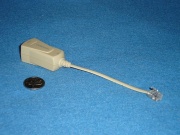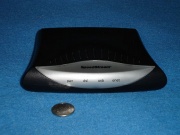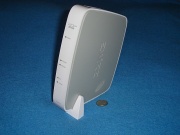Asymmetric Digital Subscriber Line
From Computing and Software Wiki
ADSL (Asymmetric Digital Subscriber Line) is one of the leading methods of providing high-speed Internet service to subscribers. ADSL is a variant of DSL, with the A standing for Asymmetric, not Asynchronous as many people incorrectly believe it to be. The service is said to be asymmetric because the available upstream bandwidth is much less than the downstream bandwidth. Though there are some limitations imposed on the technology such as maximum bandwidth, and maximum distance from the Central Office, ADSL continues to be a competitive force in the Internet service market.
Contents |
History
Historically internet was served to people's homes through the use of voice frequency data modems connect to the existing copper telephone line network. This network consists of twister pair copper wires which run back to the telephone company's central office. The voice frequency data modem made use of the same frequencies as human speech, up to about 3.4kHz, and as such was only able to achieve speeds of up to 56Kbps. This also had the disadvantage of tying up the phone line whenever the modem was in use. ADSL makes use of other frequencies which are not needed by traditional telephony services, allowing an ADSL signal to exist on a copper line in addition to a voice signal. Traditionally when ADSL was run to a home, a whole home splitter was installed at the demarkation point (???), where the phone line comes in from the street to the home. The splitter would filter all exisiting phone lines in the home, and provide an unfiltered line for use by the ADSL modem. This approached proved to be rather expensive for the ISP as they would have to cover the cost of the splitter, as well as the technician who would go out and do the installation. Most ISPs have now adopted a much more passive stance where they ship the ADSL modem with a number of microfilters which users will have to place on each of their telephones. While cheaper for this ISP, this can lead to degredation of service of the consumer if they have more than X telephonic devices in their home. The reason for this is that the branching of the various phone lines causes reflections, which interfere with the ADSL signal. A whole home splitter solves this problem in that there are no reflections; the ADSL modem is connected directly to the splitter, and is alone on an unfiltered line.
Functionality
ADSL differs from standard DSL in that the data flow is asymmetric; the data flow is greater in one direction. This is due to the observation that most people use the Internet in a fairly passive fashion. Requests are made for websites or files, which are then downloaded from the Internet. The size of the site/file requests is small relative to the files and websites they are downloading. As the Internet grows, so too does the size of the files people are downloading, and the size of the websites they are visiting. It makes sense that users should have a greater ability to download and view these files. In fact, even though the upload pipeline is very small, it has only recently begun to be used to its full bandwidth. The advent of technologies such as Bit Torrent, which focuses on equal uploading and downloading, has finally begun to use the full upload bandwidth. PICTURE OF PIPES HERE
The Future of ADSL
See Also
References
--Durandal 10:47, 9 April 2008 (EDT)




